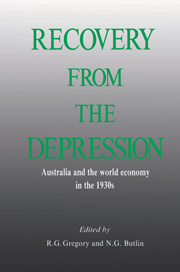Book contents
- Frontmatter
- Contents
- LIST OF AUTHORS
- LIST OF FIGURES
- LIST OF TABLES
- PREFACE
- 1 AN OVERVIEW
- 2 THE AUSTRALIAN RECOVERY OF THE 1930s IN INTERNATIONAL COMPARATIVE PERSPECTIVE
- 3 THE RECOVERY OF THE 1930s AND ECONOMIC POLICY IN BRITAIN
- 4 A MACRO INTERPRETATION OF RECOVERY: AUSTRALIA AND CANADA
- 5 DEPRESSION AND RECOVERY IN NEW ZEALAND
- 6 THE JAPANESE ECONOMY AND ECONOMIC POLICY IN THE 1930s
- 7 THE BATTLE OF THE PLANS: A MACROECONOMETRIC MODEL OF THE INTERWAR ECONOMY
- 8 AUSTRALIAN BUDGETARY POLICIES IN THE 1930s
- 9 MONETARY POLICY IN DEPRESSION AND RECOVERY
- 10 SHARING THE BURDEN: THE AUSTRALIAN LABOUR MARKET DURING THE 1930s
- 11 MANUFACTURING AND ECONOMIC RECOVERY IN AUSTRALIA, 1932–1937
- 12 AGRICULTURE AND THE RECOVERY FROM THE DEPRESSION
- 13 UNEMPLOYMENT AND THE AUSTRALIAN ECONOMIC RECOVERY OF THE 1930s
- 14 GOVERNMENT UNEMPLOYMENT RELIEF IN THE 1930s: AID OR HINDRANCE TO RECOVERY?
- 15 UNEQUAL SACRIFICE: DISTRIBUTIONAL ASPECTS OF DEPRESSION AND RECOVERY IN AUSTRALIA
- REFERENCES
- INDEX
9 - MONETARY POLICY IN DEPRESSION AND RECOVERY
Published online by Cambridge University Press: 24 November 2009
- Frontmatter
- Contents
- LIST OF AUTHORS
- LIST OF FIGURES
- LIST OF TABLES
- PREFACE
- 1 AN OVERVIEW
- 2 THE AUSTRALIAN RECOVERY OF THE 1930s IN INTERNATIONAL COMPARATIVE PERSPECTIVE
- 3 THE RECOVERY OF THE 1930s AND ECONOMIC POLICY IN BRITAIN
- 4 A MACRO INTERPRETATION OF RECOVERY: AUSTRALIA AND CANADA
- 5 DEPRESSION AND RECOVERY IN NEW ZEALAND
- 6 THE JAPANESE ECONOMY AND ECONOMIC POLICY IN THE 1930s
- 7 THE BATTLE OF THE PLANS: A MACROECONOMETRIC MODEL OF THE INTERWAR ECONOMY
- 8 AUSTRALIAN BUDGETARY POLICIES IN THE 1930s
- 9 MONETARY POLICY IN DEPRESSION AND RECOVERY
- 10 SHARING THE BURDEN: THE AUSTRALIAN LABOUR MARKET DURING THE 1930s
- 11 MANUFACTURING AND ECONOMIC RECOVERY IN AUSTRALIA, 1932–1937
- 12 AGRICULTURE AND THE RECOVERY FROM THE DEPRESSION
- 13 UNEMPLOYMENT AND THE AUSTRALIAN ECONOMIC RECOVERY OF THE 1930s
- 14 GOVERNMENT UNEMPLOYMENT RELIEF IN THE 1930s: AID OR HINDRANCE TO RECOVERY?
- 15 UNEQUAL SACRIFICE: DISTRIBUTIONAL ASPECTS OF DEPRESSION AND RECOVERY IN AUSTRALIA
- REFERENCES
- INDEX
Summary
Introduction
In some important respects, the task facing economic policy-makers during the depression and recovery of the 1930s resembled the situation some fifty years later in the mid-1980s. A sharp fall in the terms of trade—by around 20 per cent in 1929–30 and 37 per cent over the following two years—contributed substantially to a marked deterioration in the balance of payments. Those developments compounded difficulties arising from a decade of rapidly growing net overseas indebtedness. In addition, the short-term flexibility of wages policy (until 1931 determined by cost-of-living adjustments) and fiscal policy was limited, implying that short-term adjustment of macroeconomic variables would fall mainly on monetary policy.
There were also profound differences between the two periods. There was no well-developed central bank in the late 1920s and the 1930s; the Australian financial system of the 1980s is both sophisticated and closely linked with international money markets; the exchange rate has floated since late 1983; and the external debt in the 1920s had primarily been issued by the public sector—in sharp contrast to the 1980s. In addition, the Scullin Labor Government in the depression had no special relationship with the union movement resembling that enjoyed by the Hawke Government.
In broad terms the nature of the initial policy responses was similar in both periods. In the 1930s, contractionary fiscal policies (with the objective of achieving greater balance between the sources and uses of domestic savings) and wages policy (with the objective of containing domestic costs and limiting private consumption) achieved substantial restraint. Monetary policy—or rather exchange rate policy—undoubtedly contributed to slowdown in the economy in 1930 and 1931 consistent with the external constraint.
- Type
- Chapter
- Information
- Recovery from the DepressionAustralia and the World Economy in the 1930s, pp. 193 - 216Publisher: Cambridge University PressPrint publication year: 1989
- 1
- Cited by



